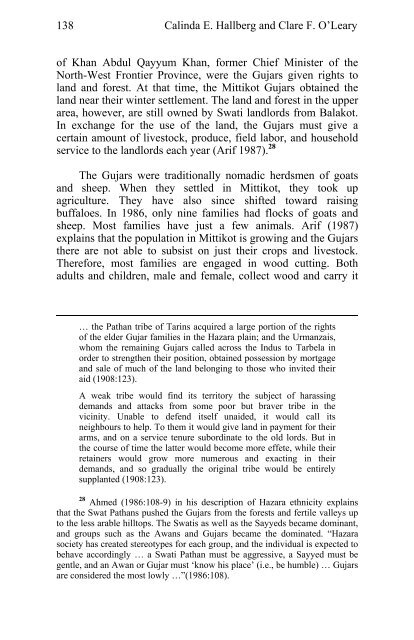Hindko and Gujari. c - SIL International
Hindko and Gujari. c - SIL International
Hindko and Gujari. c - SIL International
Create successful ePaper yourself
Turn your PDF publications into a flip-book with our unique Google optimized e-Paper software.
138<br />
Calinda E. Hallberg <strong>and</strong> Clare F. O’Leary<br />
of Khan Abdul Qayyum Khan, former Chief Minister of the<br />
North-West Frontier Province, were the Gujars given rights to<br />
l<strong>and</strong> <strong>and</strong> forest. At that time, the Mittikot Gujars obtained the<br />
l<strong>and</strong> near their winter settlement. The l<strong>and</strong> <strong>and</strong> forest in the upper<br />
area, however, are still owned by Swati l<strong>and</strong>lords from Balakot.<br />
In exchange for the use of the l<strong>and</strong>, the Gujars must give a<br />
certain amount of livestock, produce, field labor, <strong>and</strong> household<br />
service to the l<strong>and</strong>lords each year (Arif 1987). 28<br />
The Gujars were traditionally nomadic herdsmen of goats<br />
<strong>and</strong> sheep. When they settled in Mittikot, they took up<br />
agriculture. They have also since shifted toward raising<br />
buffaloes. In 1986, only nine families had flocks of goats <strong>and</strong><br />
sheep. Most families have just a few animals. Arif (1987)<br />
explains that the population in Mittikot is growing <strong>and</strong> the Gujars<br />
there are not able to subsist on just their crops <strong>and</strong> livestock.<br />
Therefore, most families are engaged in wood cutting. Both<br />
adults <strong>and</strong> children, male <strong>and</strong> female, collect wood <strong>and</strong> carry it<br />
… the Pathan tribe of Tarins acquired a large portion of the rights<br />
of the elder Gujar families in the Hazara plain; <strong>and</strong> the Urmanzais,<br />
whom the remaining Gujars called across the Indus to Tarbela in<br />
order to strengthen their position, obtained possession by mortgage<br />
<strong>and</strong> sale of much of the l<strong>and</strong> belonging to those who invited their<br />
aid (1908:123).<br />
A weak tribe would find its territory the subject of harassing<br />
dem<strong>and</strong>s <strong>and</strong> attacks from some poor but braver tribe in the<br />
vicinity. Unable to defend itself unaided, it would call its<br />
neighbours to help. To them it would give l<strong>and</strong> in payment for their<br />
arms, <strong>and</strong> on a service tenure subordinate to the old lords. But in<br />
the course of time the latter would become more effete, while their<br />
retainers would grow more numerous <strong>and</strong> exacting in their<br />
dem<strong>and</strong>s, <strong>and</strong> so gradually the original tribe would be entirely<br />
supplanted (1908:123).<br />
28 Ahmed (1986:108-9) in his description of Hazara ethnicity explains<br />
that the Swat Pathans pushed the Gujars from the forests <strong>and</strong> fertile valleys up<br />
to the less arable hilltops. The Swatis as well as the Sayyeds became dominant,<br />
<strong>and</strong> groups such as the Awans <strong>and</strong> Gujars became the dominated. “Hazara<br />
society has created stereotypes for each group, <strong>and</strong> the individual is expected to<br />
behave accordingly … a Swati Pathan must be aggressive, a Sayyed must be<br />
gentle, <strong>and</strong> an Awan or Gujar must ‘know his place’ (i.e., be humble) … Gujars<br />
are considered the most lowly …”(1986:108).

















